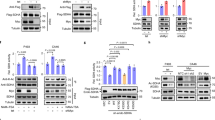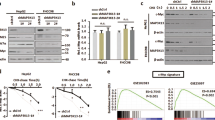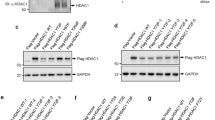Abstract
Myc oncoproteins and histone deacetylases (HDACs) modulate gene transcription and enhance cancer cell proliferation, and HDAC inhibitors are among the most promising new classes of anticancer drugs. Here, we show that N-Myc and c-Myc upregulated HDAC2 gene expression in neuroblastoma and pancreatic cancer cells, respectively, which contributed to N-Myc- and c-Myc-induced cell proliferation. Cyclin G2 (CCNG2) was commonly repressed by N-Myc and HDAC2 in neuroblastoma cells and by c-Myc and HDAC2 in pancreatic cancer cells, and could be reactivated by HDAC inhibitors. 5-bromo-2′-deoxyuridine incorporation assays showed that transcriptional repression of CCNG2 was, in part, responsible for N-Myc-, c-Myc- and HDAC2-induced cell proliferation. Dual crosslinking chromatin immunoprecipitation assay demonstrated that N-Myc acted as a transrepressor by recruiting the HDAC2 protein to Sp1-binding sites at the CCNG2 gene core promoter. Moreover, HDAC2 was upregulated, and CCNG2 downregulated, in pre-cancerous and neuroblastoma tissues from N-Myc transgenic mice, and c-Myc overexpression correlated with upregulation of HDAC2 and repression of CCNG2 in tumour tissues from pancreatic cancer patients. Taken together, our data indicate the critical roles of upregulation of HDAC2 and suppression of CCNG2 in Myc-induced oncogenesis, and have significant implications for the application of HDAC inhibitors in the prevention and treatment of Myc-driven cancers.
This is a preview of subscription content, access via your institution
Access options
Subscribe to this journal
Receive 50 print issues and online access
$259.00 per year
only $5.18 per issue
Buy this article
- Purchase on Springer Link
- Instant access to full article PDF
Prices may be subject to local taxes which are calculated during checkout







Similar content being viewed by others
References
Bennin DA, Don AS, Brake T, McKenzie JL, Rosenbaum H, Ortiz L et al. (2002). Cyclin G2 associates with protein phosphatase 2A catalytic and regulatory B’ subunits in active complexes and induces nuclear aberrations and a G1/S phase cell cycle arrest. J Biol Chem 277: 27449–27467.
Biankin AV, Kench JG, Colvin EK, Segara D, Scarlett CJ, Nguyen NQ et al. (2009). Expression of S100A2 calcium-binding protein predicts response to pancreatectomy for pancreatic cancer. Gastroenterology 137: 558–568, 568 e1-11.
Bolden JE, Peart MJ, Johnstone RW . (2006). Anticancer activities of histone deacetylase inhibitors. Nat Rev Drug Discov 5: 769–784.
Brodeur GM . (2003). Neuroblastoma: biological insights into a clinical enigma. Nat Rev Cancer 3: 203–216.
Fernandez PC, Frank SR, Wang L, Schroeder M, Liu S, Greene J et al. (2003). Genomic targets of the human c-Myc protein. Genes Dev 17: 1115–1129.
Fraga MF, Ballestar E, Villar-Garea A, Boix-Chornet M, Espada J, Schotta G et al. (2005). Loss of acetylation at Lys16 and trimethylation at Lys20 of histone H4 is a common hallmark of human cancer. Nat Genet 37: 391–400.
Fritsche P, Seidler B, Schuler S, Schnieke A, Gottlicher M, Schmid RM et al. (2009). HDAC2 mediates therapeutic resistance of pancreatic cancer cells via the BH3-only protein NOXA. Gut 58: 1399–1409.
Hansford LM, Thomas WD, Keating JM, Burkhart CA, Peaston AE, Norris MD et al. (2004). Mechanisms of embryonal tumor initiation: distinct roles for MycN expression and MYCN amplification. Proc Natl Acad Sci USA 101: 12664–12669.
Hrzenjak A, Moinfar F, Kremser ML, Strohmeier B, Staber PB, Zatloukal K et al. (2006). Valproate inhibition of histone deacetylase 2 affects differentiation and decreases proliferation of endometrial stromal sarcoma cells. Mol Cancer Ther 5: 2203–2210.
Huang BH, Laban M, Leung CH, Lee L, Lee CK, Salto-Tellez M et al. (2005). Inhibition of histone deacetylase 2 increases apoptosis and p21Cip1/WAF1 expression, independent of histone deacetylase 1. Cell Death Differ 12: 395–404.
Kim Y, Shintani S, Kohno Y, Zhang R, Wong DT . (2004). Cyclin G2 dysregulation in human oral cancer. Cancer Res 64: 8980–8986.
Kurland JF, Tansey WP . (2008). Myc-mediated transcriptional repression by recruitment of histone deacetylase. Cancer Res 68: 3624–3629.
Li LH, Nerlov C, Prendergast G, MacGregor D, Ziff EB . (1994). c-Myc represses transcription in vivo by a novel mechanism dependent on the initiator element and Myc box II. Embo J 13: 4070–4079.
Liu T, Tee AE, Porro A, Smith SA, Dwarte T, Liu PY et al. (2007). Activation of tissue transglutaminase transcription by histone deacetylase inhibition as a therapeutic approach for Myc oncogenesis. Proc Natl Acad Sci USA 104: 18682–18687.
Mahlamaki EH, Barlund M, Tanner M, Gorunova L, Hoglund M, Karhu R et al. (2002). Frequent amplification of 8q24, 11q, 17q, and 20q-specific genes in pancreatic cancer. Genes Chromosomes Cancer 35: 353–358.
Maris JM, Matthay KK . (1999). Molecular biology of neuroblastoma. J Clin Oncol 17: 2264–2279.
Marks P, Rifkind RA, Richon VM, Breslow R, Miller T, Kelly WK . (2001). Histone deacetylases and cancer: causes and therapies. Nat Rev Cancer 1: 194–202.
Nowak DE, Tian B, Brasier AR . (2005). Two-step cross-linking method for identification of NF-kappaB gene network by chromatin immunoprecipitation. Biotechniques 39: 715–725.
Patel JH, Loboda AP, Showe MK, Showe LC, McMahon SB . (2004). Analysis of genomic targets reveals complex functions of MYC. Nat Rev Cancer 4: 562–568.
Pelengaris S, Khan M, Evan G . (2002). c-MYC: more than just a matter of life and death. Nat Rev Cancer 2: 764–776.
Raetz EA, Kim MK, Moos P, Carlson M, Bruggers C, Hooper DK et al. (2003). Identification of genes that are regulated transcriptionally by Myc in childhood tumors. Cancer 98: 841–853.
Rolink A, Kudo A, Karasuyama H, Kikuchi Y, Melchers F . (1991). Long-term proliferating early pre B cell lines and clones with the potential to develop to surface Ig-positive, mitogen reactive B cells in vitro and in vivo. Embo J 10: 327–336.
Schleger C, Verbeke C, Hildenbrand R, Zentgraf H, Bleyl U . (2002). c-MYC activation in primary and metastatic ductal adenocarcinoma of the pancreas: incidence, mechanisms, and clinical significance. Mod Pathol 15: 462–469.
Stossi F, Likhite VS, Katzenellenbogen JA, Katzenellenbogen BS . (2006). Estrogen-occupied estrogen receptor represses cyclin G2 gene expression and recruits a repressor complex at the cyclin G2 promoter. J Biol Chem 281: 16272–16278.
Weichert W, Roske A, Niesporek S, Noske A, Buckendahl AC, Dietel M et al. (2008). Class I histone deacetylase expression has independent prognostic impact in human colorectal cancer: specific role of class I histone deacetylases in vitro and in vivo. Clin Cancer Res 14: 1669–1677.
Won J, Yim J, Kim TK . (2002). Sp1 and Sp3 recruit histone deacetylase to repress transcription of human telomerase reverse transcriptase (hTERT) promoter in normal human somatic cells. J Biol Chem 277: 38230–38238.
Xu G, Bernaudo S, Fu G, Lee DY, Yang BB, Peng C . (2008). Cyclin G2 is degraded through the ubiquitin-proteasome pathway and mediates the antiproliferative effect of activin receptor-like kinase 7. Mol Biol Cell 19: 4968–4979.
Zhu P, Martin E, Mengwasser J, Schlag P, Janssen KP, Gottlicher M . (2004). Induction of HDAC2 expression upon loss of APC in colorectal tumorigenesis. Cancer Cell 5: 455–463.
Zimmermann S, Kiefer F, Prudenziati M, Spiller C, Hansen J, Floss T et al. (2007). Reduced body size and decreased intestinal tumor rates in HDAC2-mutant mice. Cancer Res 67: 9047–9054.
Acknowledgements
The authors are supported by an NIH project grant (T L), a Career Development and Support Fellowship from Cancer Institute NSW (T L and AVB), NHMRC (TL and GMM) and Cancer Council NSW (TL, AVB and CJS) project grants, NHMRC, Cancer Institute NSW and Cancer Council NSW programme grants (GMM, MH and MDN), Italian Association for Research on Cancer (GP), NHMRC Postdoctoral Training Fellowships (CJS and TT). Children′s Cancer Institute Australia is affiliated with University of New South Wales and Sydney Children's Hospital.
Author information
Authors and Affiliations
Corresponding authors
Ethics declarations
Competing interests
The authors declare no conflict of interest.
Additional information
Supplementary Information accompanies the paper on the Oncogene website
Supplementary information
Rights and permissions
About this article
Cite this article
Marshall, G., Gherardi, S., Xu, N. et al. Transcriptional upregulation of histone deacetylase 2 promotes Myc-induced oncogenic effects. Oncogene 29, 5957–5968 (2010). https://doi.org/10.1038/onc.2010.332
Received:
Revised:
Accepted:
Published:
Issue Date:
DOI: https://doi.org/10.1038/onc.2010.332
Keywords
This article is cited by
-
Synergistic effect of HDAC inhibitor Chidamide with Cladribine on cell cycle arrest and apoptosis by targeting HDAC2/c-Myc/RCC1 axis in acute myeloid leukemia
Experimental Hematology & Oncology (2023)
-
Epigenetic alterations and advancement of treatment in peripheral T-cell lymphoma
Clinical Epigenetics (2020)
-
Calreticulin regulates MYCN expression to control neuronal differentiation and stemness of neuroblastoma
Journal of Molecular Medicine (2019)
-
Identification of Jun loss promotes resistance to histone deacetylase inhibitor entinostat through Myc signaling in luminal breast cancer
Genome Medicine (2018)
-
Epigenetic targeting of Notch1-driven transcription using the HDACi panobinostat is a potential therapy against T-cell acute lymphoblastic leukemia
Leukemia (2018)



